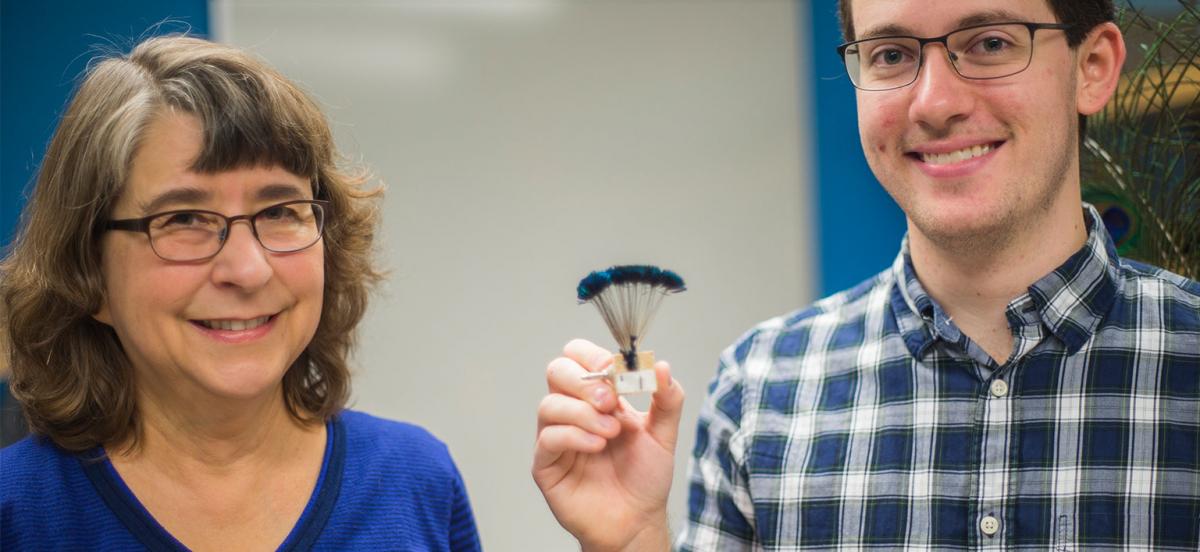Suzanne Amador Kane and Daniel Van Beveren ’20 Publish on Peacocks

Professor Suzanne Amador Kane and Daniel Van Beveren '20 in the lab in Hilles with peacock feathers that they used to observe different vibrations on. Photo by Patrick Montero.
Details
The Haverford physics professor and the physics major co-authored a paper in PLOS ONE describing findings about the biomechanics of peafowl crests during social displays.
The summer after his first year at Haverford, Daniel Van Beveren ’20 stayed on campus to conduct research with Professor of Physics Suzanne Amador Kane. Kane has, for some time, been interested in the biomechanical structure and functions of the feathers of male peacock and female peahen. Van Beveren was excited to work alongside the professor of his “Introductory Mechanics” class and to learn how analyzing a biological system in terms of its mechanical characteristics could help better understand it.
“One of the reasons I find the subject matter interesting is that biophysics gives a really nice example of just how broadly the principles of physics can be applied,” said the now junior physics major from Chesapeake, Virginia.
The results of that summer's research was published in a paper this week in PLOS ONE (co-authored with Roslyn Dakin of the Smithsonian Migratory Bird Center and the University of Ottawa) that announces findings of sensory functions for peafowl head feathers, known as crests, during social displays, such as the shaking motion the birds do during courtship.
“I have long been fascinated by the remarkable mechanical properties of bird feathers,” says Kane, noting that in different species they can do everything from providing thermal insulation to allowing for flight, and, even, acting like whiskers to help “see” in the dark. “I wondered if the feather crests might serve a different type of sensory function in peacocks. These birds—like many others that have long, elaborate head crests featured on both males and females—perform elaborate dance-like displays in which they shake their bodies so as to create what's called ‘mechanical sound.’ We also know that insects and other arthropods can detect this kind of sound using their sensory hairs. So, I set Daniel the task of finding out which frequencies peafowl head crests responded to best—and he immediately came back to report it was the very same frequency the peacocks use during their displays!”
Van Beveren was an essential part of the research team and is listed as a second author on the paper. He helped design the experiments, performed most of them, wrote MATLAB programs to analyze the data, and designed many of the experimental apparatuses, including a robot that mimicked wing-flapping in a peafowl courtship display. Though it is not unusual for Haverford science students to publish with their faculty mentors, Van Beveren being listed as a second author on a published paper for work he did as a first-year is, in the words of Kane, “extraordinary.”
“Daniel exhibits the best of Haverford—he's a social, outgoing student with lots of interests and enthusiasms outside science, yet he's also exceptionally talented as a laboratory scientist and keenly motivated by the love of science,” she says. “I'm extremely impressed by his creativity, maturity, and independence in performing research at this early stage of his college career.”
The paper, “Biomechanics of the Peafowl’s Crest Reveals Frequencies Tuned to Social Displays,” represents an important first step in understanding not just peafowl head crests, which had long been thought to be purely ornamental, but the purposes and uses of feathers more broadly.
“Feathers are being studied as novel biomaterials, not only for their importance in a specific biological and behavioral setting,” says Kane. “ For example, we showed that crest feathers could serve as ultrasensitive airflow detectors in robotic and other applications. There are already robots that communicate using air vortices for which this would provide enhance sensitivity.”
Though this research was limited to exploring the biomechanical properties of this system, Kane is eager to follow up this work by filming high-speed, close-up videos of the motions of feather crests during actual courtship displays by live birds.
“Nature,” she says, “is always surprising us.”
Press on this research:
The Atlantic
Science
Phys.org
Science Daily
Daily Mail
New Scientist



